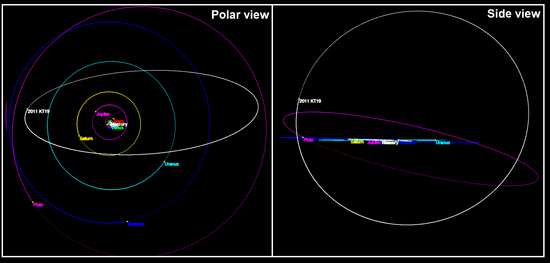| Discovery[1] | |
|---|---|
| Discovered by | Mount Lemmon Srvy. List
|
| Discovery site | Mount Lemmon Obs. |
| Discovery date | 31 May 2011 |
| Designations | |
| Pronunciation | /ˈniːkuː/ |
Named after | A Chinese adjective meaning "rebellious" [2] |
| Niku | |
| TNO[3] · centaur[4] damocloid | |
| Orbital characteristics[3] | |
| Epoch JD 2457600.5 | |
| Uncertainty parameter 2 | |
| Observation arc | 1779 days (4.87 yr) |
| Aphelion | 47.427 AU |
| Perihelion | 23.7805 AU |
| 35.604 AU | |
| Eccentricity | 0.33208 |
| 212.45 years | |
| 29.487° | |
| Inclination | 110.1537° |
| 243.77772° | |
| 322.174° | |
| TJupiter | −1.552 |
| Physical characteristics | |
Mean diameter | 75–250 km[5] 161 km[4] |
| 22[6] | |
| 7.2[5][3] | |
(471325) 2011 KT19, nicknamed Niku (/niːkuː/), is a trans-Neptunian object whose orbit is tilted 110° with respect to the planets' orbital plane. Thus, it has a nearly polar retrograde orbit around the Sun.[2][7][8][9]
While the object has not received a formal name, it received the moniker "Niku" (逆骨), meaning "rebellious" in the Chinese language, by its discoverers.[10][11]
YouTube Encyclopedic
-
1/1Views:332
-
El objeto más extraño del Sistema Solar
Transcription
Details
(471325) 2011 KT19 was discovered by the Mount Lemmon Survey on 31 May 2011. Its rediscovery was announced in August 2016 by a team of astronomers using the Pan-STARRS telescope. It was soon linked with a supposed prograde centaur (2011 KT19; inclination = 38° and semi-major axis = 28 AU) that had been lost due to a short observation arc.[1][7] 2011 KT19 is in a 7:9 resonance with Neptune. Currently it is the only object with a nearly polar orbit that is in resonance with a planet.[12] Notably, it is part of a group of objects that orbit the Sun in a highly inclined orbit; the reasons for this unusual orbit are unknown as of August 2016.[13]
The orbital characteristics of 2011 KT19 have been compared to those of 2008 KV42 (Drac). The orbits of 2011 KT19, 2008 KV42, 2002 XU93, 2010 WG9, 2007 BP102, 2011 MM4, appear to occupy a common plane, with three in prograde and three in retrograde orbits. The probability of this alignment occurring by chance is 0.016%. These orbits should leave a common plane in a few million years because the precession of prograde and retrograde orbits are in opposite directions. Simulations including the hypothetical Planet Nine did not maintain a common orbital plane and the plane does not coincide with the plane of the predicted high-inclination large semi-major axis objects of that model. Other simulations with a few Earth-mass dwarf planet on a high-inclination orbit also failed to reproduce the alignment.[7]

|
| The orbit of 2011 KT19 in relation to Pluto and the planets of the Solar System |

|
| The orbit of Niku (purple), is shown with another steep retrograde TNO, Drac (yellow), and the other planets. Pluto's orbit is in red. |
References
- ^ a b "MPEC 2011-L09 : 2011 KT19". IAU Minor Planet Center. 2 June 2011. (K11K19T; E-assumed due to short arc)
- ^ a b "Mystery object in weird orbit beyond Neptune cannot be explained". New Scientist. 10 August 2016. Archived from the original on 11 August 2016. Retrieved 11 August 2016.
- ^ a b c "JPL Small-Body Database (2011 KT19)". JPL. NASA. Retrieved 12 August 2016.
- ^ a b Johnston, Wm. Robert (18 August 2020). "List of Known Trans-Neptunian Objects". Johnston's Archive. Retrieved 18 July 2021.
- ^ a b "IAU Minor Planet Center - 2011 KT19". Minor Planet Center. IAU. Retrieved 12 August 2016.
- ^ "AstDyS (471325) 2011KT19 Ephemerides". Retrieved 18 February 2017.
- ^ a b c Chen, Ying-Tung; Lin, Hsing Wen; Holman, Matthew J; Payne, Matthew J; et al. (5 August 2016). "Discovery of A New Retrograde Trans-Neptunian Object: Hint of A Common Orbital Plane for Low Semi-Major Axis, High Inclination TNOs and Centaurs". The Astrophysical Journal. 827 (2): L24. arXiv:1608.01808. Bibcode:2016ApJ...827L..24C. doi:10.3847/2041-8205/827/2/L24. S2CID 4975180.
- ^ Charles Q. Choi (2016-10-24). "What's Up with 'Niku'? Object's Weird Orbit Puzzles Scientists". Space.com. Retrieved 2022-12-21.
- ^ "What Makes the Solar System Like a Crime Scene? - Science Friday". 19 August 2016. Retrieved 19 August 2016.
- ^ Grossman, David (11 August 2016). "Meet Niku, the Weird Object Beyond Neptune That Nobody Can Figure Out". Popular Mechanics. Retrieved 21 December 2021.
- ^ Choi, Charles Q. (24 October 2016). "What's Up with 'Niku'? Object's Weird Orbit Puzzles Scientists". Space.com. Retrieved 21 December 2021.
- ^ Morais, M. H. M.; Nomouni, F. (2017). "First transneptunian object in polar resonance with Neptune". Letters. Monthly Notices of the Royal Astronomical Society. 472 (1): L1–L4. arXiv:1708.00346. Bibcode:2017MNRAS.472L...1M. doi:10.1093/mnrasl/slx125.
- ^ Dalton, Andrew (10 August 2016). "There's something weird going on beyond Neptune". Engadget. AOL. Retrieved 11 August 2016.



